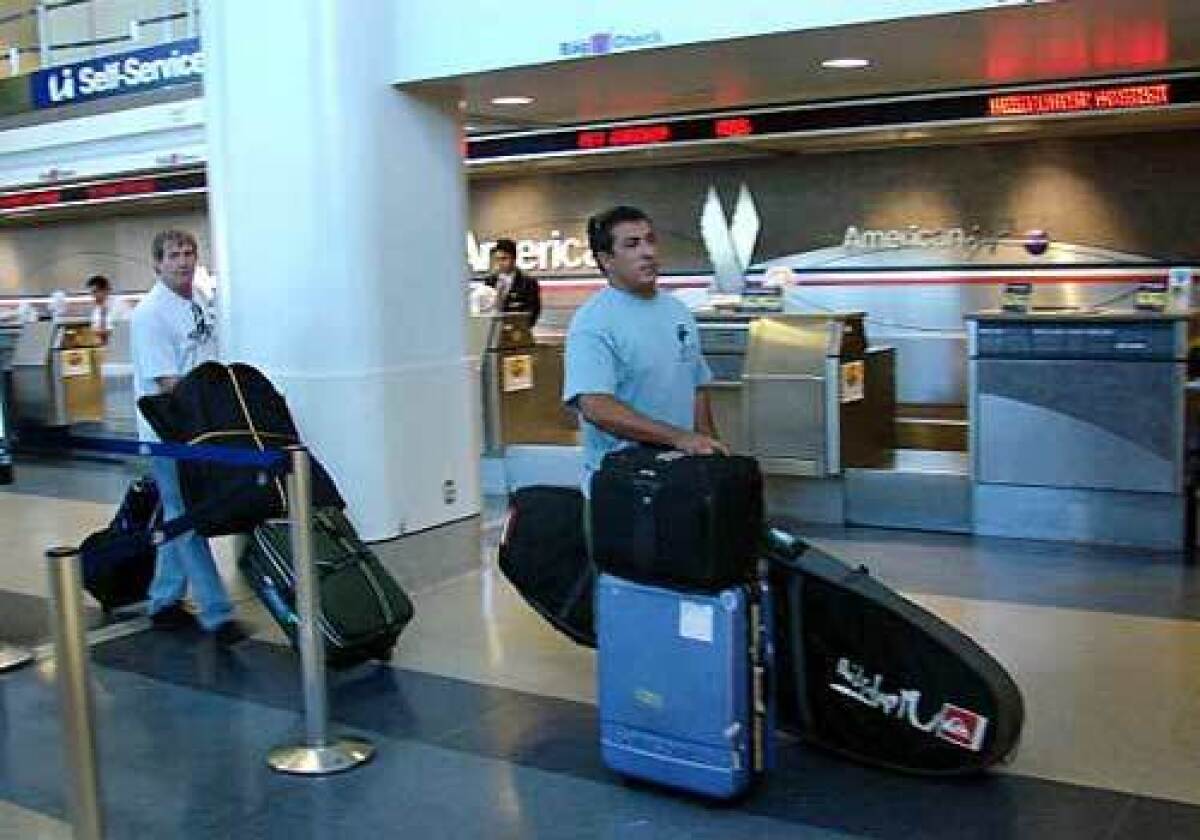Airlines’ fees for surfboards are dinging surfers

Swelling airline fees are wiping out traveling surfers’ hopes of catching the next big wave.
Some airlines are now charging surfers as much as $300 to take along a surfboard. That’s significantly higher than the $15 fee that big carriers began charging for the first checked bag, a move that has riled passengers.
The fee, among the highest of airline charges, is grounding some surfers and has created an unusual uproar among an otherwise mellow surf community. Fees for bicycles, skis and other sports equipment have also been rising, but not as much as surfboard.
Surfers note that most airlines don’t charge for golf bags, while surfers are paying as much as $300 a board for international flights. That’s nearly as much as a new board can cost. Avid surfers take as many as four boards in a bag, which can mean a $1,200 bill, or $2,400 for a round trip.
Last year, British Airways, despite petitions from 14,000 surfers, went so far as to ban surfboards altogether.
“Why are we being singled out?” asked Evan Slater, a surfer and editor in chief of San Clemente-based Surfing magazine. “It’s not like we’re carrying nuclear weapons, and these surfboards aren’t much heavier than a carry-on.”
The charges have gotten so gnarly that some professional surfers are calling for a boycott of airlines that have high fees and are putting out their own personal lists of surfer-friendly carriers that wave riders should patronize. One of the hottest surfing websites is now also a guide to airline fees.
“It’s a big issue for us,” said Rusty Long, a San Clemente-based professional surfer who spends nine months out of the year traveling in search of the big wave. “It’s ridiculous when you’re having to pay more for your board than the price of your airline ticket.”
Long was on Nantucket Island, Mass., this week but was looking to chase a swell moving up the East Coast. He said he has been telling his fans to avoid Delta Air Lines, Continental Airlines and United Airlines.
Charges on those carriers can exceed $150 a board, depending on the destination. He recommends JetBlue Airways, which charges $50 a board, and international carriers such as Qantas Airways and Air New Zealand, which don’t charge for surfboards.
Surfers say they’ve considered shipping their surfboards via FedEx or United Parcel Service but the cost can range from a few hundred dollars to several thousands depending on the destination. Renting a board can also be expensive. Renting a decent board can cost as much as $100 a day, and most travelers spend several days or more surfing on a trip.
Because of the high fees, Long said he’s cut back on eating out and partying when traveling.
“You have to skip nice meals and give up that nice bottle of tequila,” he said.
U.S. airlines have been raising fares and fees on such things as the first checked bag and on-board pillows and drinks -- all of which were once included in the price of a plane ticket -- as a way to raise additional revenue amid a steep increase in fuel costs.
The surfboard fees are high because the boards require special care and extra handling, Delta said. They don’t go through the normal baggage carousel but must be carried on special elevators to the claims area.
“There are handling costs associated with surfboards that we have to account for,” Delta spokesman Kent Landers said. The hike in charges also reflects a general increase in fees to “cover and reflect the unprecedented increase in fuel costs,” he added.
Fuel costs, which have increased more than 70% since last year, could leave the industry with more than $6 billion in losses this year, according to an airline trade group.
But surfers contend that the fees for their boards are unfairly high compared with other items. Although they are large and need special handling as an oversize bag, a typical short board weighs about 4 pounds while a larger board may swell to only 15 pounds.
“It’s not the weight thing,” said Marcus Sanders, a Huntington Beach surfer and editor of surfing website Surfline.com, whose airline fee guide received 20,000 hits in the first two days it was posted last month. “They just think that it’s an extra pain on their employees, that the boards take up extra space on their planes and that we make up a small percentage of its passengers.”
At Los Angeles International Airport on Wednesday, Mark Cowan was hit with an $80 fee for his kite board, which resembles a small surfboard that a rider stands on as he is pulled across the water by a large kite.
The fee charged by Hawaiian Airlines was on top of the extra $100 Cowan paid Delta to fly from Colorado to Los Angeles before his connecting flight to the island of Oahu.
“You know, I just realized I’m going to be paying $360 to take my board along,” Cowan, a Ridgway, Colo., resident, said after checking in his board, which was 4 feet, 9 inches long and weighed about 11 pounds. “It’s robbery.”
If the fees get any higher, Cowan said he may forgo taking his board along and buy one at his destination since it could cost about the same as the airline fee, or about $400 a board. Like other avid surfers, Cowan said renting a used board was out of the question.
To cut the fee he faced, surfboard maker Danny Villasenor decided to leave one of his two demo boards behind in Los Angeles instead of taking it back home to Oahu. He was in Southern California trying to sell his custom boards.
American Airlines used to charge $25 a surfboard, Villasenor said, but the fee jumped to $100 recently.
“If it gets any higher I’ll have to bring pictures” of the boards instead, Villasenor said, adding that he felt particularly sympathetic to the plight of surfers. “Most of these guys who travel with their boards don’t have money. They don’t stay in fancy resorts. They go to catch a wave and camp.”
More to Read
Sign up for The Wild
We’ll help you find the best places to hike, bike and run, as well as the perfect silent spots for meditation and yoga.
You may occasionally receive promotional content from the Los Angeles Times.






